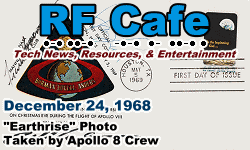Day in Engineering History Archive - December 24 |
|
1818: James Joule, discoverer of the current/resistance/heat relationship and after whom the unit of energy is named, was born. 1865: Several veterans of the Confederate Army formed a private social club called the Ku Klux Klan (U.S. Senator Robert Byrd, of WV, was a KKK Exalted Cyclops when in his 30s). 1872: Scottish physicist William Rankine, an early investigator of thermodynamics who developed the Rankine Cycle, died. 1873: Johns Hopkins, endower of the college named after him, died. 1904: Billionaire Howard Hughes was born. 1906: Reginald Fessenden gave what is generally considered to be the first broadcast of entertainment by radio. 1947: The point-contact transistor, invented days earlier by American physicists John Bardeen, Walter H. Brattain, and William Shockley, was presented to Bell Labs management. 1963: New York International Airport was rededicated as John F. Kennedy Airport. 1966: The unmanned Russian Luna 13 spacecraft landed on Moon. 1968: The crew of the Apollo 8 spacecraft, the first manned mission to the moon, transmitted a Christmas message from lunar orbit. 1968: Astronauts on Apollo 8 became the first men to orbit the Moon, and took the famous "Earthrise" photo. 1979: The first European-built rocket, Ariane 1, successfully completed its maiden flight. | Jan | Feb | Mar | Apr | May | Jun | Jul | Aug | Sep | Oct | Nov | Dec | Note: These historical tidbits have been collected from various sources, mostly on the Internet. As detailed in this article, there is a lot of wrong information that is repeated hundreds of times because most websites do not validate with authoritative sources. On RF Cafe, events with hyperlinks have been verified. Many years ago, I began commemorating the birthdays of notable people and events with special RF Cafe logos. Where available, I like to use images from postage stamps from the country where the person or event occurred. Images used in the logos are often from open source websites like Wikipedia, and are specifically credited with a hyperlink back to the source where possible. Fair Use laws permit small samples of copyrighted content. |
 December 24
December 24